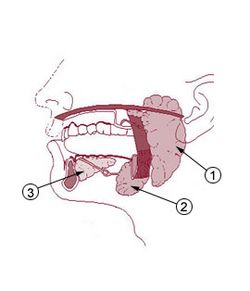Digestive enzyme facts for kids
Digestive enzymes are like tiny helpers in your body. They are special enzymes that break down the food you eat. Imagine your food as big puzzle pieces. Digestive enzymes break these big pieces into much smaller ones. This way, your body can easily absorb and use the nutrients from your food.
These important enzymes are found in the digestive systems of animals, including humans. They are also found in some carnivorous plants. They help these plants digest the insects they catch.
In your body, digestive enzymes are found in several places. They are in your saliva, which comes from your salivary glands. They are also in your stomach, in juices from your pancreas, and in your small and large intestines.
What are Digestive Enzymes?
Digestive enzymes are proteins that speed up chemical reactions. Their main job is to break down large food molecules. These molecules include fats, proteins, and carbohydrates. Once broken down, these smaller pieces can pass into your bloodstream. Your body then uses these nutrients for energy, growth, and repair.
Types of Digestive Enzymes
Digestive enzymes are grouped by what they break down. Each type has a specific job:
- Lipases break down fats and oils. They turn them into smaller fatty acids.
- Proteases and peptidases break down proteins. They turn them into tiny peptides and amino acids. Amino acids are the building blocks of proteins.
- Amylases break down carbohydrates. This includes things like starch and sugars. They turn them into simple sugars like glucose. Glucose is your body's main energy source.
- Nucleases break down nucleic acids. These are the genetic materials in food. They turn them into nucleotides.
Where are Enzymes Found?
In the human body, digestion mainly happens in three places: your mouth, your stomach, and your small intestine. Different glands and cells release digestive enzymes in these areas:
- Salivary glands: These are in your mouth. They produce saliva, which contains amylase. This enzyme starts breaking down carbohydrates as you chew.
- Gastric glands: These are in the lining of your stomach. They produce enzymes like pepsin. Pepsin helps break down proteins.
- Pancreas: This organ releases a powerful mix of enzymes. These include amylase, lipase, and proteases. They are sent into your small intestine.
- Small intestine: The walls of your small intestine also have special cells. These cells produce enzymes that finish the job of digestion.
These enzymes work together to make sure your body gets all the nutrients it needs from the food you eat.
See also
 In Spanish: Enzima digestiva para niños
In Spanish: Enzima digestiva para niños


